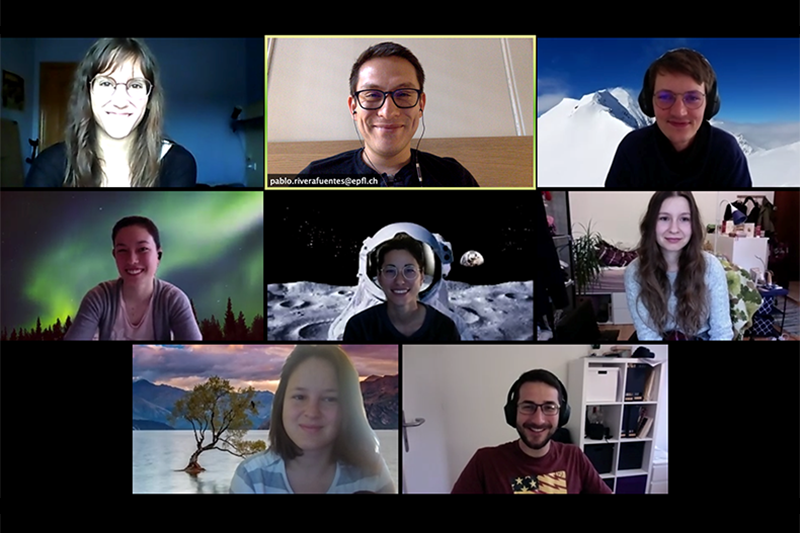“Biology presents the challenge and we use chemistry to find a solution“. This is the way Prof. Pablo Rivera-Fuentes, tenure-track assistant professor at the EPFL and NCCR Chemical Biology member, describes his vision of interdisciplinarity applied to his research. After almost a year at EPFL, the Rivera-Fuentes lab is now settled in a brand-new lab space and is continuing the work started at the ETH Zürich in 2015. Their research focuses on the development of photoswitchable probes and dyes for monitoring cellular processes and enzymatic activity using high resolution microscopy imaging. In this article, we explore how did the Rivera-Fuentes lab build and develop its scientific expertise.

Setting the foundations of the lab’s research
Over the past few years, there has been a lot of interest in developing fluorescent probes capable of measuring the concentration of certain analytes, or specific chemical properties, in subcellular compartments. It is in this context that Prof. Pablo Rivera-Fuentes started the Laboratory Of Chemical and Biological Probes (LOCBP) at ETH Zürich:
“We thought that it would be interesting not only to measure these concentrations and properties in subcellular compartments, but to actually control them.”
In the early days, a PhD student (Alina Tirla) and a postdoc (Giovanni Bassolino) started testing out some ideas of photoactivatable groups that could be used for delivering small molecules to intracellular organelles. These two initial members helped shape the current research interests of the lab.
On the one hand, Alina became interested in modulating redox homeostasis in subcellular organelles and was able to develop a photoactivatable phosphine for this very purpose.
Subsequently, another PhD student (Jade Nguyen) took this research to the next level by developing probes which can be activated by endogenous enzymes that are naturally overexpressed in certain organelles. This new strategy provides excellent selectivity and does not require the use of light for activation. The team nevertheless keeps an interest for light-activatable molecules and is still working on them for other applications.
On the other hand, Giovanni did a lot of the ground work on photoactivation in the lab, and one of his interests was to develop reversibly photoswitchable dyes for super-resolution microscopy. The idea was ambitious, and could not be completed during Giovanni’s postdoc. Another PhD student (Elias Halabi) carried the project forward, and developed two classes of photoactivatable fluorophores that are now widely used in the group:
- single-molecule fluorescent
- photoregulated fluxional fluorophores
Examples include the work of two additional PhD students (Zacharias Thiel and Adam Eordogh) who used single-molecule sensors for practical applications, including activity-based enzyme imaging in live cells, and lipid tracking in subcellular domains. In addition, another PhD student (Salome Püntener) is currently exploring applications of fluxional fluorophores beyond super-resolution microscopy.
Ongoing projects in Prof. Pablo Rivera-Fuentes’ group include exploring what are the consequences of disrupting redox homeostasis in various organelles, such as the endoplasmic reticulum (Sarah Hübner) or the Golgi apparatus (Carla Miró). The Rivera-Fuentes lab is also working on developing entirely new strategies to label proteins with fluorescent dyes for super-resolution microscopy, a project lead by a PhD student, Annabell Martin.
Consolidating and re-thinking the research
After obtaining encouraging proof-of-principle results, the group is now moving towards consolidating some of its ideas, including through collaborations to go deeper into biological experiments. They are also exploring new applications for fluxional fluorophores and are even starting a project to come up with new methods to measure uptake of antibiotics in bacteria.
Concerning the current context, Prof. Pablo Rivera-Fuentes sees the EPFL campus shutdown due to Covid-19 as an opportunity “to re-think our research directions and to step up our data mining and machine learning game”, techniques that they will be leveraging much more in the future.
To the question of how the team combines chemistry and biology in its research, Prof. Pablo Rivera-Fuentes says:
“One of the driving forces of our research is to create molecules that have specific functions. Biology presents a multitude of challenges, and a molecule with a given function, such as targeting a specific target/organelle, providing special photophysical properties or triggering signaling, can be a potential solution for those challenges. In other words, biology presents the challenge and we use chemistry to find a solution”.
This perfectly summarizes the goals of the NCCR Chemical Biology, highlighting how the research of the Rivera-Fuentes lab fits nicely within it. We are looking forward to seeing where their ground-breaking and innovative work goes next!
 Pablo Rivera-Fuentes received his MSc (2009) and PhD (2012) degrees in chemistry from ETH Zurich. Funded by the SNSF, he carried out postdoctoral research at Massachusetts Institute of Technology with Prof. Stephen J. Lippard. He subsequently worked at the University of Oxford with Prof. Harry L. Anderson, FRS (Department of Chemistry) and Prof. Christian Eggeling (Weatherall Institute of Molecular Medicine). He started his independent career as non-tenure-track assistant professor at ETH Zurich in 2015, and became tenure-track assistant professor of chemical biology at EPFL and member of the NCCR Chemical Biology in 2019. His main interests are focused on the development of targeted photoactivatable probes, on fluorescent sensing of epigenetic modifications and on the development of photoswitchable dyes for high resolution imaging.
Pablo Rivera-Fuentes received his MSc (2009) and PhD (2012) degrees in chemistry from ETH Zurich. Funded by the SNSF, he carried out postdoctoral research at Massachusetts Institute of Technology with Prof. Stephen J. Lippard. He subsequently worked at the University of Oxford with Prof. Harry L. Anderson, FRS (Department of Chemistry) and Prof. Christian Eggeling (Weatherall Institute of Molecular Medicine). He started his independent career as non-tenure-track assistant professor at ETH Zurich in 2015, and became tenure-track assistant professor of chemical biology at EPFL and member of the NCCR Chemical Biology in 2019. His main interests are focused on the development of targeted photoactivatable probes, on fluorescent sensing of epigenetic modifications and on the development of photoswitchable dyes for high resolution imaging.

Leave a comment
The editors reserve the right not to publish comments or to abridge them.